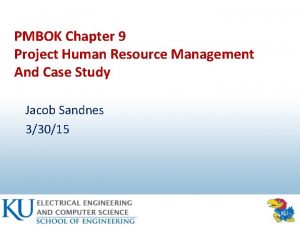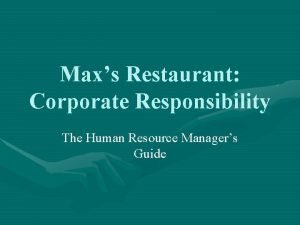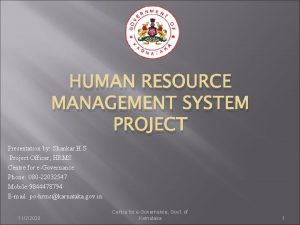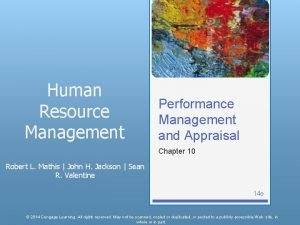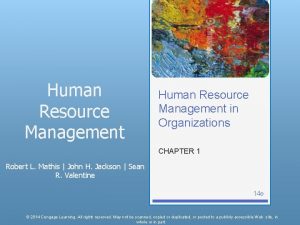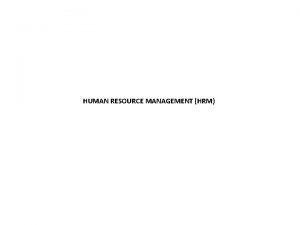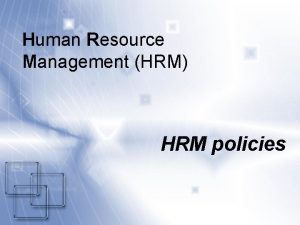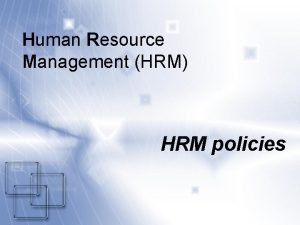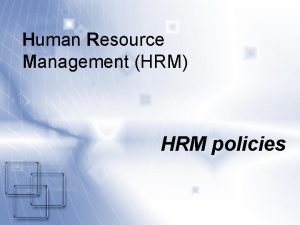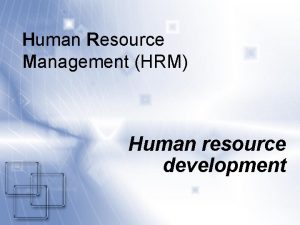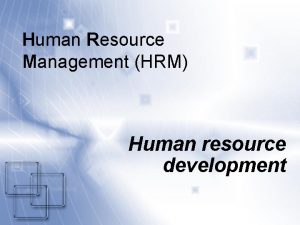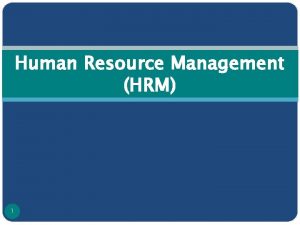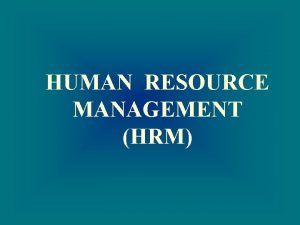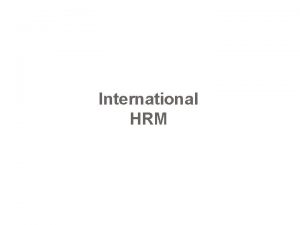HUMAN RESOURCE MANAGEMENT HRM HRM defined as HRM













- Slides: 13

HUMAN RESOURCE MANAGEMENT (HRM) HRM defined as “HRM is management function concerned with hiring , motivating and maintaining people in an organization. It focuses on people in organization”

HRM: Peoples Dimensions In Organizations • • • HRM: the application of management functions and principles related to employees HRM functions applicable every where (not for profit and profit driven organizations) Employees decisions are integrated Employee decision brings effectiveness/efficiency in organization HRM includes all major activities in professional life of a worker All activities from employee entry to managing performance and training until he or she leaves

HRM Activities • HR Planning • Job Analysis and Design • Recruitment and Selection • Training and Development • Remuneration • Welfare • Safe and Healthy Work Environment • Industrial relations

SCOPE OF HRM 1. Introduction to HRM 2. Employee Hiring 3. Employee Remuneration 4. Employee Motivation 5. Employee Maintenance 6. Industrial Relations 7. Prospects of HRM

Scope Of HRM Prospects of HRM Career Development IR Introduction of HRM Employee Maintenance Source: Aswathappa, 2008, p. 6 Employee Hiring Employee Remuneration Employee Motivation

Differences Between HRM and PM Dimensions 1. Employment contract 2. Rules 3. Guide to management action 4. Behaviour referent 5. Managerial task vis-à-vis labor 6. Speed of decision 7. Management role 8. Communication 9. Prized management skills PM Care full delineation of written contracts Importance of devising clear rules Procedures HRM Aim to go behind contract Can do outlook, impatience with rule Business need Norms , customs and practices Values and mission Monitoring Nurturing Slow Transactional Indirect Negotiation Fast Transformational leadership Direct Facilitation 10. Selection 11. Labour management 12. Job categories and grade Separate , marginal task Integrated, key task Collective barraging contracts Individual contracts Many Few 13. Job design 14. Conflict handling Division of labour Reach temporary truce Team work Manage climate and culture

Differences Between HRM and PM Dimensions PM 15. Respect for employees Labour is used as tool which Peoples are used as assets to is spendable and replaceable be used for the benefit of organization 16. Shared interest Interest of organizations are uppermost Precedes HRM 17. Evolution HRM 18. Locus of control 19. Oganization principles External Mechanistic Top down centralized 20. Key relations 21. Initiatives 22. Pay 23. Training and development Labour Management Piecemeal Job evaluation Controlled accessed to courses Mutuality of interest Latest in evolution of subjects Internal Organic Bottom-up Decentralized Customers Integrated Performance related Learning companies Source: Aswathappa, 2008, p. 7

HRM Functions and Objectives • The main objective of HRM is to ensure the availability of willing and competent force to an organization • There are other objective of HRM too 1. Societal objectives 2. Functional objectives 3. Organizational objectives 4. Personal objectives

HRM FUNCTIONS AND OBJECTIVES Societal Objectives Organizational Objectives Functional Objectives Personal Objectives Source: Aswathappa, 2008, p. 8

HRM Functions and Objectives 1 Societal objectives • Societal objectives of HRM make sure that the organization is socially and ethically responsible • Minimizing negative impact of societal demands on organizations • For example: EOE laws forces organizations to be ethical in recruitment, to minimize the discrimination against hiring based on ethnicity, race, and religion etc.

HRM Functions and Objectives 2 Organizational objectives • To determine the role of HRM in organizational effectiveness • Its purpose is to assist/serve organization • HR department also serve other departments

HRM Functions and Objectives 3 Functional objectives • • To maintain department contribution in organizational effectiveness HR department services must fit into the organizational needs

HRM Functions and Objectives 4 Personal objectives • To assist employees in achieving their personal/individual goals • Maximum contribution to organization • Personal objectives are achieved when employees are satisfied, motivated and retained • Satisfied employees excellent services excellent organizational performance
 Time management in human resource management
Time management in human resource management Retail management retail store organizational chart
Retail management retail store organizational chart Role of personnel management
Role of personnel management A collection well defined objects
A collection well defined objects Project human resource management pmbok ppt
Project human resource management pmbok ppt Resource management pmbok
Resource management pmbok Importance of human resources management
Importance of human resources management Recruitment process of max's restaurant
Recruitment process of max's restaurant Induction in hrm
Induction in hrm Hrm chapter 2
Hrm chapter 2 Chapter 9 human resources management
Chapter 9 human resources management Human resource management system project ppt
Human resource management system project ppt Mbo performance appraisal method
Mbo performance appraisal method Current issues in human resource management
Current issues in human resource management





